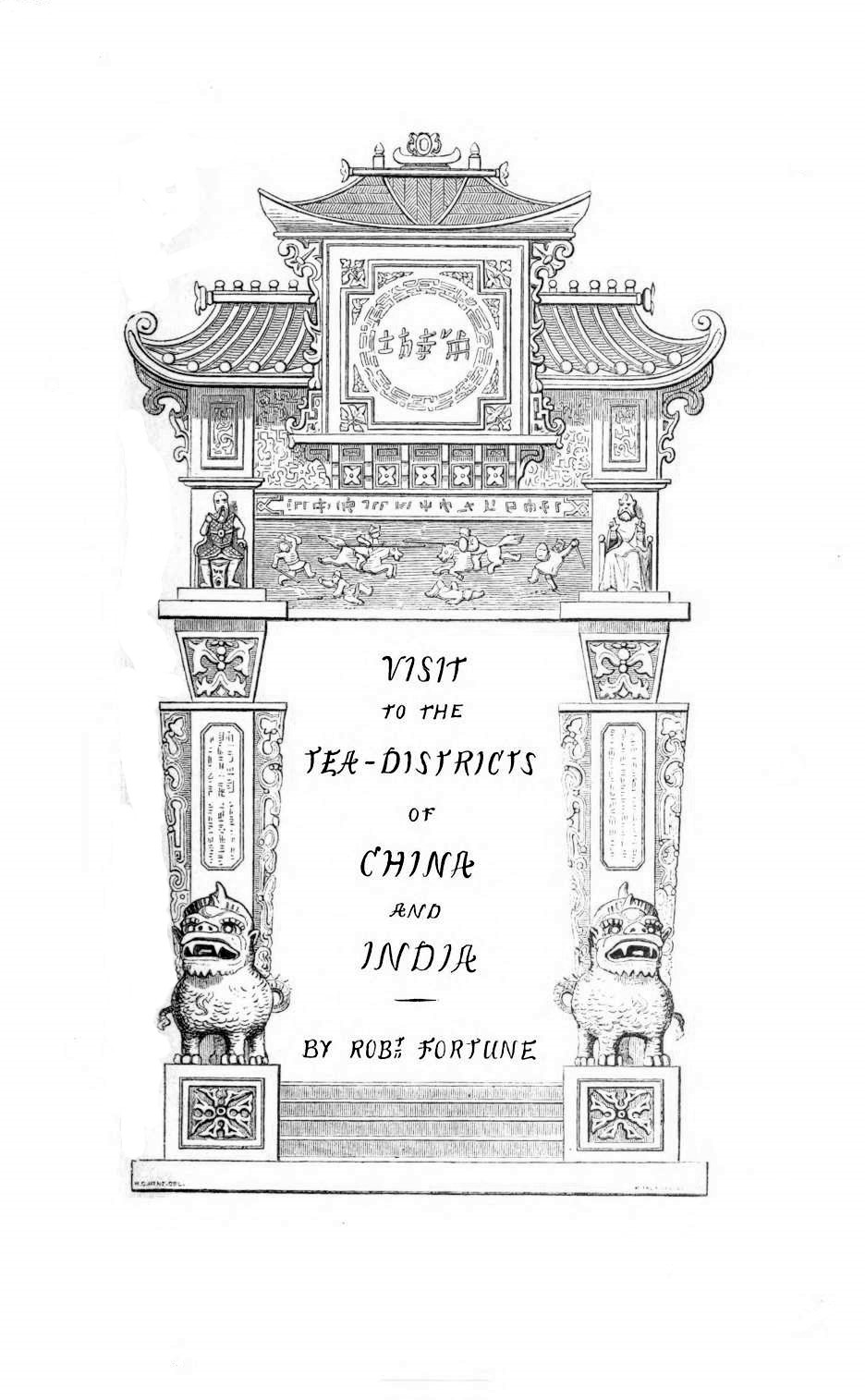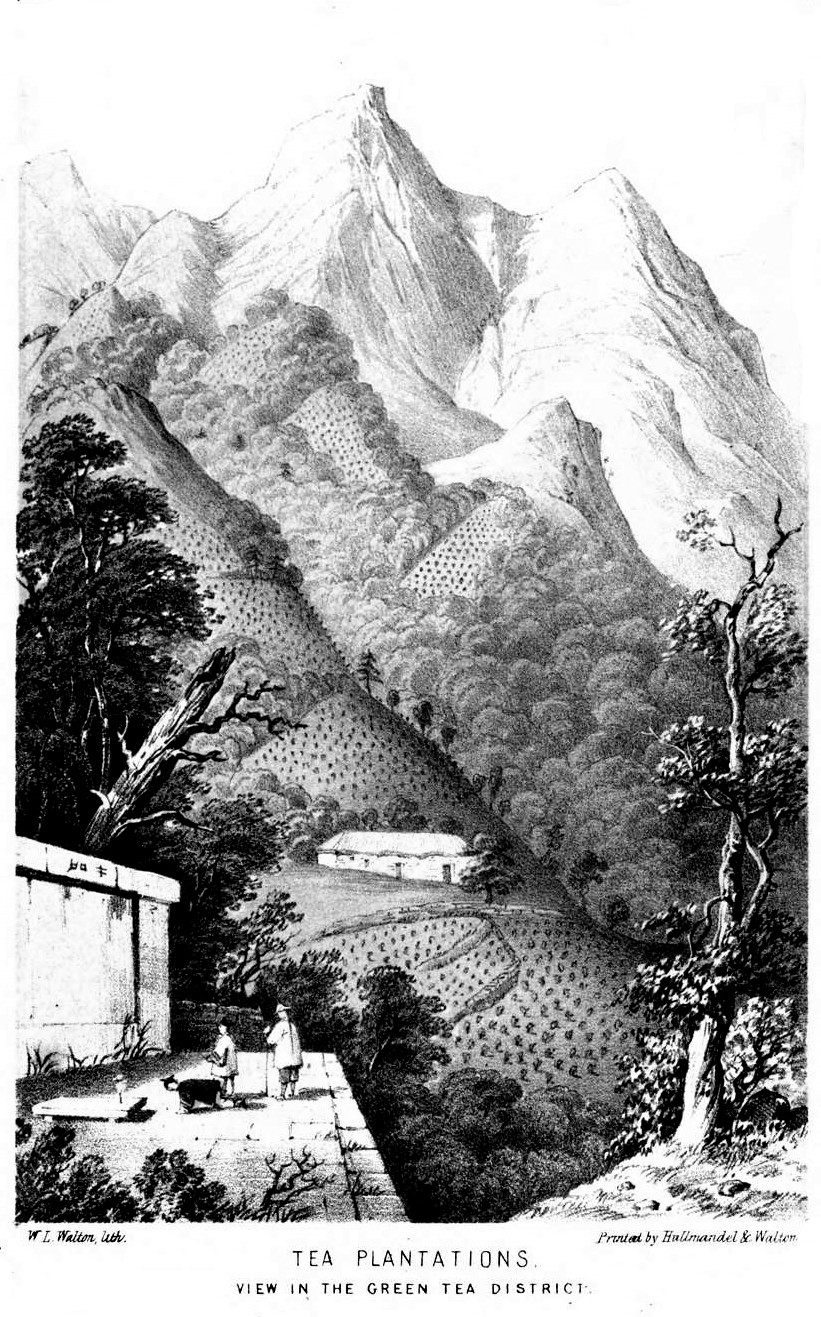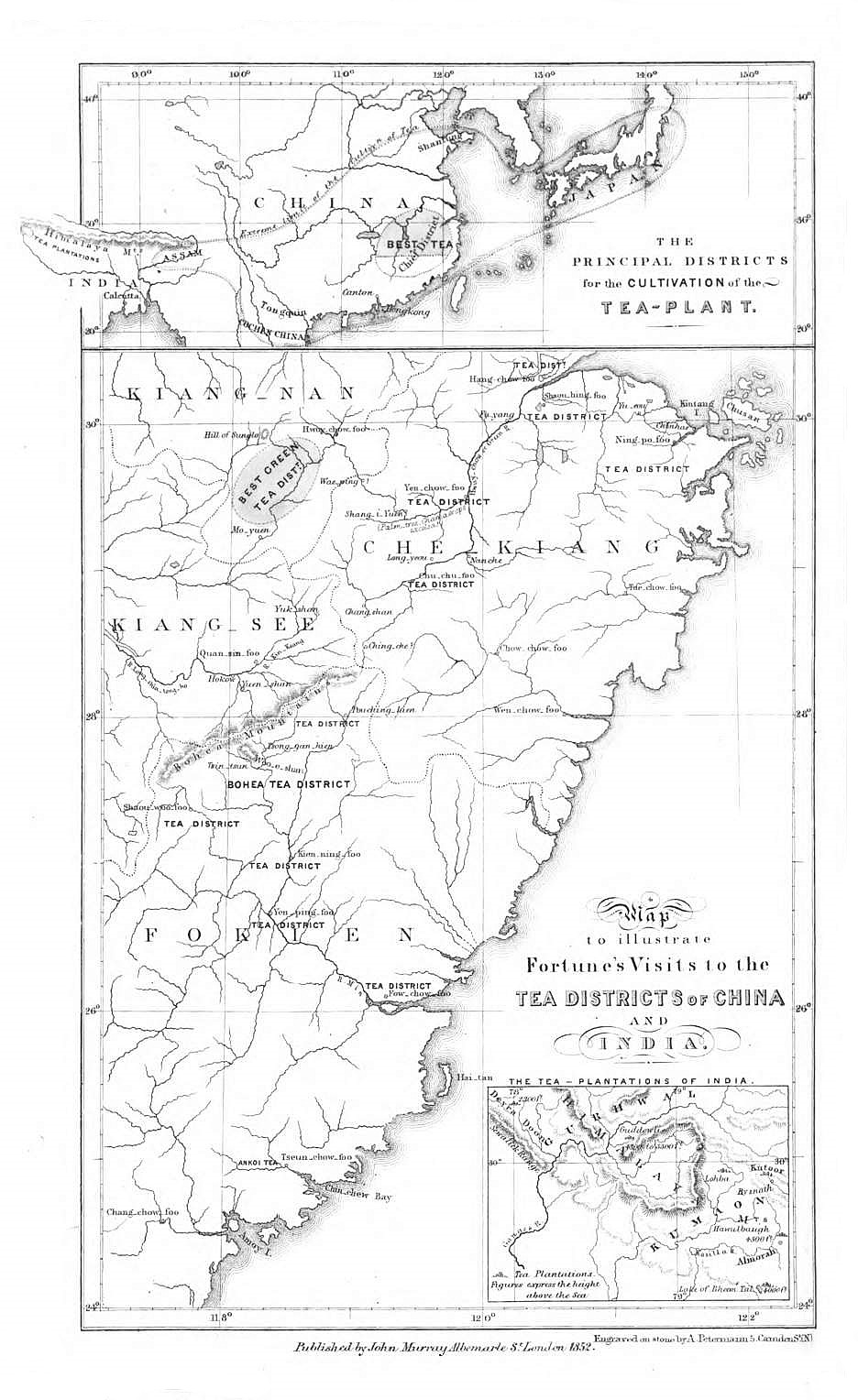 |
|
||
| Kellscraft
Studio Home Page |
Wallpaper
Images for your Computer |
Nekrassoff Informational Pages |
Web
Text-ures© Free Books on-line |
 A JOURNEY TO THE TEA COUNTRIES OF CHINA; INCLUDING SUNG-LO AND THE BOHEA HILLS; WITH A SHORT NOTICE OF THE EAST INDIA COMPANY’S TEA PLANTATIONS IN THE HIMALAYA MOUNTAINS. BY ROBERT FORTUNE, AUTHOR OF 'THREE YEARS' WANDERINGS IN CHINA.' WITH MAP AND ILLUSTRATIONS. LONDON: JOHN MURRAY, ALBEMARLE STREET 1852.  PREFACE. IT is now about five years
since I submitted to the public my 'Three Years' Wanderings in the
Northern
Provinces of China.' Shortly after the publication of that volume I was
deputed
by the Honourable the Court of Directors of the East India Company to
proceed
to China for the purpose of obtaining the finest varieties of the
Tea-plant, as
well as native manufacturers and implements, for the Government Tea
plantations
in the Himalayas. On the 20th of June, 1848, I
left Southampton,
with many other passengers, in the Peninsular and Oriental Company's
steam-ship
'Ripon,' Captain Moresby, I.N., and landed in Hong-kong on the 14th
of August. As I went far inland, and
visited many districts almost unknown to Europeans, I now venture to
lay an
account of my travels and their results before the public. Blessed with
a sound
constitution and good health, I cared little for luxuries, and made
light of
the hardships of a traveller's life. New scenes, new countries, and new
plants
were day by day spread out before me and afforded gratification of the
highest
and purest kind. And even now, when on a different side of the globe
and far
removed from such scenes and such adventures, I often look back upon
them with
feelings of unalloyed pleasure. The important objects of my
mission have been brought to a successful termination. Upwards of
twenty thousand
tea-plants, eight first-rate manufacturers, and a large supply of
implements
were procured from the finest tea-districts of China, and conveyed in
safety to
the Himalayas. In the course of my travels I discovered many useful and
ornamental trees and shrubs, some of which, such as the Funereal
Cypress,
will one day produce a striking and beautiful effect in our English
landscape
and in our cemeteries. In publishing this account
of my journey I may repeat what I said in the introduction to my former
'Wanderings:'
— "I have no intention of writing or making a book
upon
China." My object is to give a peep into the Celestial Empire, to show
its
strange hills and romantic valleys, its rivers and canals, its natural
productions, whether in the field, on the hillside, or in the garden,
and its
strange and interesting people, as they were seen by me in their
every-day
life. As I hope my readers will accompany me through the whole of my
journey, I
shall have the pleasure of taking them to India and the Himalayas, and
showing
them the Government Tea plantations, from which much is expected, and
which are
likely to prove of great advantage, not only to India but also to
England and
her wide-spreading colonies. Having thus given an idea
of what may be expected in the following pages, I have only to express
a hope
that the work may be received by the public in the same kind spirit,
and with
the same indulgence and favour, that were shown to my former
'Wanderings.' Brayton, April, 1852. CONTENTS. CHAPTER I Arrive at
Hong-kong —
Excitement on the arrival of the mail — Centipede boats — Bay of
Hong-kong by
moonlight — Town of Victoria — Its trees and gardens — Mortality
amongst the
troops — Its cause — A remedy suggested — Sail for Shanghae — Its
importance as
a place of trade — New English town and shipping — The gardens of the
foreign
residents
CHAPTER II My object in
coming
north — Difficulty in procuring tea-plants — No dependence can be
placed upon
the Chinese — Adopt the dress of the country — Start for the interior —
Mode of
getting my head shaved — City of Kea-hing-foo and its old cemetery —
Lakes and
"ling"— Mode of gathering the ling — Great silk country — Increase in
exports — City of Seh-mun-yuen — Fear of thieves — Hang-chow-foo — The
"Garden of China" — Description of the city and its suburbs — Gaiety
of the people — Adventure in the city — Kan-du — A "chop" — A Chinese
inn — I get no breakfast and lose my dinner — Boat engaged for
Hwuy-chow —
Importance of Hang-chow both for trading and "squeezing"
CHAPTER III Leave
Hang-chow-foo —
A China passage-boat — Scenery and natural productions — Remarkable
hills — Our
fellow-passengers — A smoker of opium — I am discovered to be a
foreigner —
City of Yen-chow-foo — A Chinaman cheats a Chinaman! — The river and
water-mills — Botany of the country — A valuable palm-tree — Birds —
Lime-kilns
and green granite — Tea-plant met with — The new FUNEREAL CYPRESS
discovered —
Its beauty — How its seeds were procured — Dr. Lindley's opinion of its
merits
— Strange echo — River and land beggars — Charity
CHAPTER IV City of
Wae-ping —
Threatened attack from boatmen — A false alarm — A border country and a
border
guard — Enter the district of Hwuy-chow — The tea-plant and other crops
— A
Chinese play — Ferry-boat and ladies — Cargo transshipped — Two coffins
below
my bed — A mandarin's garden — Botany of the hills — A new plant (Berberis
japonica) — My servant's advice — Leave the boat — The
opium-smoker
outwitted — Town of Tun-che — Its importance in connection with the
tea-trade —
Features of country, soil, and productions — First view of Sung-lo-shan
CHAPTER V Sung-lo-shan
— Its priests
and tea — Its height above the sea — Rock formation — Flora of
the hills — Temperature and climate — Cultivation of the
tea-shrub — Mode of preserving its seeds — The young plants —
Method of dyeing green teas — Ingredients employed — Chinese
reason for the practice — Quantity of Prussian blue and gypsum
taken by a green-tea drinker — Such teas not used by the Chinese —
Mr. Warrington’s observations
CHAPTER VI My reception in
the
house of Wang's father — A smoky Chinese cottage — My coolie and the
dwarf —
The dangers to which they had been exposed — Chinese mode of warming
themselves
on a cold day — Tea-seeds, &c., obtained — Anecdote of the new Berberis
— Obtain some young plants of it — Deceitful character of the Chinese —
Leave
the far-famed Sung-lo-shan — Wang tries to cheat the chairmen — Invents
a story
of a "great general" — Leave Tun-che — Mountain scenery — Pleasure of
going down the river — Gale of wind amongst the mountains — Arrive at
Nechow —
Shaou-hing-foo — Tsaou-o — Pak-wan — Arrive at Ning-po
CHAPTER VII Kintang or Silver Island — Its
inhabitants and
productions — Bay of Chapoo — Advantages of an inland route — New year
at
Shanghae — Flower-shops and flowers — Sacred bamboo — The Chrysanthemum — Mode of cultivating it —
Weather-prophets
— Sail for Hong-kong —
A game-ship —
The Enkianthus — Canton seeds, and mode of packing them — False notion
regarding their being poisoned
CHAPTER VIII Foo-chow-foo
— Jealousy of the mandarins — A polite way of getting rid of a
spy — Scenery amongst the mountains — Temple of Koo-shan — Its
priests and idols — Buddha’s tooth and Other relics — Trees and
shrubs — City of Foo-chow-foo — Chinese mode of getting out when
the gates are shut — Journey up the Min — Chinese sportsmen and
their dogs — A deer-hunt — Scenery about Tein-tung — Wild
flowers — Roadside temples — The bamboo — A priest and siphon —
Lakes of Tung-hoo
CHAPTER IX Leave Ning-po
for the
Bohea mountains — My guides — A flag and its history — The Green River
again —
Spring scenery on its banks — Yen-chow and Ta-yang — A storm in a creek
—
Boatwomen — A Chinese Mrs. Caudle and a curtain lecture — Natural
productions —
Funereal cypress and other trees — Our boat seised for debt and the
sail taken
away — A Chinese creditor — Town of Nan-che — Its houses, gardens, and
trade —
Vale of Nan-che — Productions and fertility — City of Chu-chu-foo —
Moschetoes
and Mosoheto "tobacco" — Arrive at Chang-shan
CHAPTER X City
of Chang-shan
and its trade — Land journey — My chair and chair-bearers — Description
of the
road — Trains of tea coolies — Roadside inns — Boundary of two
provinces —
Dinner at a Chinese inn — Value of the chopsticks — Adventure with two
Canton
men — City of Yuk-shan — Its trade and importance — Quan-sin-foo — My
servant
speculates in grass-cloth — A Chinese test of respectability —
Description of
the country and its productions — Arrive at the town of Hokow
CHAPTER XI Town of Hokow —
Its
situation, trade, and great importance — Bohea mountain chair —
Mountain road —
Beggars by the wayside — Beautiful scenery — the priest and his bell —
Town of Yuen-shan
— Appearance of the road — Tea coolies — Different modes of carrying
the
tea-chests — Large tea-growing country — Soil and plantations — My
first night
in a Chinese inn — Reception — Dirty bed-rooms — I console myself, and
go to
dinner
CHAPTER XII First view of
the
Bohea mountains — Mountain pass — A noble fir-tree — Its name and
history —
Flora of the mountains — New plants
—
Source of the river Min — Entertainment for man and beast — A rugged
road and
another pass — A gale amongst the mountains — An amusing old
China-woman —
Sugar and tea-spoons — A kind landlord — The Tein-sin — Arrive at the
city of
Tsong-gan-hien — Its situation, size, and trade — Tea-farms
CHAPTER XIII Woo-e-shan —
Ascent
of the hill — Arrive at a Buddhist temple — Description of the temple
and the
scenery — Strange rocks — My reception — Our dinner and its ceremonies
— An
interesting conversation — An evening stroll — Formation of the rocks —
Soil —
View from the top of Woo-e-shan — A priests' grave — A view by
moonlight —
Chinese wine — Cultivation of the tea-shrub — Chains and monkeys used
in
gathering it — Tea-merchants — Happiness and contentment of the
peasantry
CHAPTER XIV Stream of "nine
windings" — A Taouist priest — His house and temple — Du Halde's
description of these hills — Strange impressions of gigantic hands on
the rocks
— Tea-plants purchased — Adventure during the night — My visitors —
Plants
packed for a journey — Town of Tsin-tsun and its trade — Leave the
Woo-e hills
— Mountain scenery — The lance-leaved pine — Rocks, ravines, and
waterfalls — A
lonely road — Trees — Birds and Other animals — Town of She-pa-ky —
Productions
of the country — Uses of the Nelumbium
— Pouching teas — City of Pouching-hien
CHAPTER XV Some advice to
the
reader — Botany of the black-tea country — Geological features — Soil —
Sites
of tea-farms — Temperature — Rainy season — Cultivation and management
of
tea-plantations — Size of farms — Mode of packing — Chop names — Route
from the
tea-country to the coast — Method of transport — Distances — Time
occupied —
Original cost of tea in the tea-country — Expenses of carriage to the
coast —
Sums paid by the foreign merchant — Profits of the Chinese — Prospect
of good
tea becoming cheaper — Tüng-po's directions for making tea — His
opinion on its
properties and uses
CHAPTER XVI Geography of
the
tea-shrub — Best tea districts of China — Names of tea-plants — Black
and green
tea made from the same variety — My Chinamen asked to make tea from Pongamia
glabra — They succeed! — Difference between black and green
tea depends
upon manipulation — Method of making green tea — of making black —
Difference
in the manipulation of the two kinds — Mr. Warrington's remarks on this
subject
— A familiar illustration — The tea-plant — Inferior teas made from Thea
bohea — Best teas made from Thea viridis
— The Woo-e-shan variety —
The tea-plant affected by climate and reproduction — Tea cultivation in
America
and Australia — In English gardenss
CHAPTER XVII Inn at Pouching-hien —
Opium-smokers and gamblers —
Value of life in China — A midnight disturbance — Sing-Hoo fights with
a
joss-stick — Difficulty of procuring men next day — Sing-Hoo carries
the
luggage, and we march — His bamboo breaks — Scene amongst beggars —
Description
of beggars in China — A "king of the beggars" — Charity always given
— I continue my journey — Mountain passes and Buddhist temples — A
border town
and Tartar guard — We are inspected and allowed to pass on
CHAPTER XVIII A celebrated Buddhist
temple — Scenery around it — Its trees and shrubs — Buddhist worship — Leave
the temple — Reflections on Buddhism — Important station for Christian
missionaries — Privations they would have to endure — Roman Catholics and their
labours — Christian charity — Protestant missionaries — Their views as to the
interior of China — A day-dream of China Opened — Bamboo paper — A mandarin on
a journey — Town of Ching-hoo — Engage a boat for Nechow — Return to Shanghae CHAPTER XIX Tea-plants, &c.,
taken to Hong-kong — Shipped for India — I sail again for the north — Shanghae
gardens in spring — "South Garden" — Double-striped peach and other
plants — Moutan gardens — Fine new varieties of the tree-pæony — Chinese method
of propagating them — Mode of sending them to Canton — Value there —
Introduction to Europe — Size in England — Azalea gardens — Skimmia Reevesiana
— New Azaleas — The "Kwei-wha" — The Glycine — Its native hills —
Chinese mode of training it — The yellow Camellia CHAPTER XX Safe arrival of
tea-plants in India — Means taken in China to engage tea-manufacturers — I
visit Chusan — My lodgings — A mandarin who smoked opium — His appearance at
daylight — A summer morning in Chusan — An emperor's edict — The Yang-mae —
Beauty of its fruit — City of Ting-hae — Poo-too, or Worshipping Island —
Ancient inscriptions in an unknown language — A Chinese caught fishing in the
sacred lake — He is chased by the priests — The bamboo again — The sacred
Nelumbium — My holidays expire — Collections of tea-seeds and plants made —
Return to Shanghae — Tea-manufacturers
engaged — We bid adieu to the north of China CHAPTER XXI Experiments with
tea-seeds — Best method of sending them to distant countries — How oaks and
chestnuts might be transported — Arrive at Calcutta — Condition of the
collections — East India Company's botanic garden — Amherstia and other plants
in bloom — Proceed onwards — The Sunderbunds — Arrive at Allahabad — Land
journey — Reach Saharunpore — State of the tea-plants — Saharunpore garden —
Musscoree garden — Its trees and other productions — Its value to the country
and to Europe CHAPTER XXII Ordered to inspect
the tea-plantations in India — Dens Doon plantation — Mussooree and Landour —
Flora of the mountains — Height and general character — Our mode of travelling
— Hill-plants resemble those of China — Guddowli plantation — Chinese
manufacturers located there — I bid them farewell — The country improves in
fertility — Tea-plantations near Almorah — Zemindaree plantations — Leave
Almorah for Bheem Tal — View of the Snowy range — Bheem Tal tea-plantations —
General observations on tea culture in India — Suggestions for its improvement
— Other plants which ought to be introduced — Nainee Tal — Arrive at Calcutta —
The Victoria regia
 LIST OF ILLUSTRATIONS. 1.
View in the Green Tea Country
2. Engraved Title page 3. Map 4. Curious mode of gathering the Ling near Kea-hing-foo 5. Palm-tree (Chamærops excelsa?) 6. Funereal Cypress 7. Relic-Cage 8. Buddha’s Tooth 9. Crystal Vase 10. Mo-ze, the Chinese Sportsman 11. Roadside Altar 12. Mode of carrying the finest Tea across the Bohea mountains 13. Mode of carrying common Tea 14. Chinese Tomb 15. Chinese Bird’s-eye View of the "Stream of Nine Windings" and strange Rocks 16. Ancient Inscription 17. Old Stone at Poo-too |